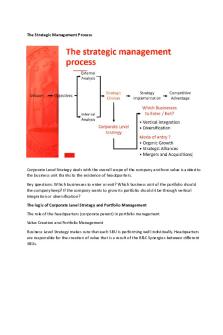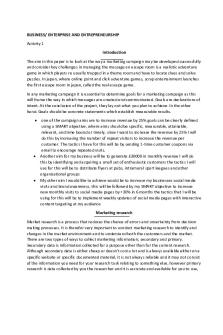Unit 3.14 - CACHE Level 3 PDF

| Title | Unit 3.14 - CACHE Level 3 |
|---|---|
| Author | Michelle Forrester |
| Course | Childcare |
| Institution | College (UK - Further and Higher Education) |
| Pages | 5 |
| File Size | 174.2 KB |
| File Type | |
| Total Downloads | 61 |
| Total Views | 154 |
Summary
CACHE Level 3...
Description
Unit 3.14 Learning Objectives 1.1 We must plan for children’s individual needs based around their level and stage of development. Some children may have other needs that we need to be able to meet, and the areas of development of the children. For early intervention some of the observations we carry out will be able to lead to identifying any additional support a child needs and the area of learning. Example: You might have a student who his not communicating or playing alongside other children, this could be that there is a speech delay or a high level of EAL, this means that a child may need extra one on one support to help assist with phonics, fine motor skills, and learning how to be more independent. Depending on the delay you may encourage outside help from a more specialized agency. When you review the environment, observations are a great way to observe and see how effective your areas are within the setting. This could be the constructive area, reading area, art/mark making area, or role play you could have an area that is lacking the needs of the children such as you may have books that aren’t interesting to the children if you don’t have many observations in that specific area etc.… As practitioners we need to look into the child’s transition or during their transition from one stage to another, throughout the setting. This is important information to share between the care giver such as parent, grandparent, nanny or other childcare providers. This information needs to be through parental consent, but it can be helpful for childcare providers so they know how the child has been and how the child may respond to the transition stage. When we are working in partnership observations, assessments, and or any other information in relation to the child whether it’s within the school or information that has been obtained outside such as speech, or occupational therapy can be extremely help to the practitioner to have a better understanding of the child, or any additional support a child may need. A child’s behavior can vary from the father, mother, grandparent, or soul caregiver and can most likely be different away from the teacher or school. We must maintain confidentiality in any case of a child except when safeguarding can be an issue. 2.1 Observations come in many different types some observations are quick and simple some are long and require more detail. When writing an observation, we must be able to write exactly what we see and be factual, it should not be your opinion. All observations require date, time, areas of learning, and how long the observation was carried out for. There are at least four methods you can use for your observations: Some setting will have their own checklist or may use commercial checklists. A Checklist is a basic series of statements or questions about specific skills that the children have acquired. Most settings use these over a
period of time for example: we would do a settling in checklist, a milestone checklist. By the end of each term we would have 19-21 spontaneous observations (you could call that post-it notes) in all 7 areas of learning and 1-2 planned observations that would help guide us to write the child’s end of term report or a summative assessment to the parents. Learning journeys where used for each child with all observations in them. The learning journey’s had pictures of the children throughout the setting, pictures of the child doing activities through child-initiated play, adult lead or focus activities. All pictures had a small description of what the child was doing, saying or playing alongside etc. All observations are very critical when recording a child’s progress and development for them moving on to the next stages of development or Key stages. 2.2 Observation methods Method Event Sample- This is a method to calculate targeted behavior of a child or specific events, this can be used for a specific event taking place of the child or behavior. Sociogram- This method is used to track a child’s interaction amongst children and adults.
Advantages Behavior won’t be missed Simple to fill in They can build a picture of a child’s response or particular behavior to specific events
Narrative- Observes facts and detail of what the child is doing, this method is flexible and about recording evidence/factual. Target Child- this records the child for up to ten-twenty minutes or more. Areas of target.
Spontaneous Flexible Observes all areas of the child’s development with specific detail
Helps with PSED Helps with transition It can help seeing if children are being neglected
Really help the observer to understand the child to an extent of a child social interaction between children and adults Level of activity of the child
Disadvantages Causes of behavior may not be able to be established It can’t be used for a group of children It can be difficult to record everything
Children maybe asked who they most enjoy being around, this could lead to them giving wrong names of a child and what they think the adult wants to hear They may tend to have frequent change of friends Fast writing, so false information will not be written or misled if the observer cannot write fast enough Time consuming Chances of distraction Child may not respond well (behavior can vary depending on the time) Focusing on one child
Can build a detailed picture of a child Checklist-This can be a series of statements, questions, or specific skills that children have acquired to check for expected development Child Tracker- This method is observed in a specific area within the setting how long a child plays there, what keeps their attention etc.
Time Sample-This is done over a period of time recording minute by minute (time is set).
Simple to use Can be used to track a group of children Repeated to track progress
Records movement of the child which area the child shows most interest in It can highlight where children are not finding the setting very stimulating
It’s very effective when observing a child efficiently Easy to use Can record observation in a less amount of time
at a time Must be able to summarize efficiently Very limited information about the child Doesn’t track or record child’s level of selfawareness/confidence or motivation Doesn’t record specific reasons why children may not be engaged when moving to one area to another Time consuming, and doesn’t record a lot of information Difficult for another key person to interpret Does not focus on causes of behavior Some children may be uncomfortable and shy away easily May miss important details of behavior
3.1-3.3 Objectivity, Subjectivity and confidentiality- are the opposite of each other and person can be subject to factors influencing an observer’s opinion Example if an observer has previous knowledge of a child, this could be from over hearing other colleague’s comments, seeing the child outside of the setting or knowing the child’s parents this could lead to biases from the observer. Objectivity is when the observer shows no sign of being bias towards the child and influenced by other’s, they record exactly what they are seeing and hearing. Objectivity is what each observer should be this will lead to 1. Accurate information about the child. 2. The child will not be “labeled” by the practitioner and give more accurate observations instead of mislead information of the child. 3. The information the observer is collecting will be complete and not subject to not following through with a full observation, but should show interest in observing the child correctly so the practitioner can plan around the child’s needs. It’s important to have confidentiality during the observation, when observing a child, you should not be speaking to other colleagues about what you are observing about the child, or allow them to see what is written or document on the child. The people who can and usually would have access to observations is the child’s parents, key person, the SENCO department in case of
additional needs, and the principal or manager of the setting. You may break confidentiality if the parent or caregiver sign a consent to give for the wellbeing of the child. 4.2 Observations Attached
5.1 It’s very important to have good partnership when working with parents within a setting. Encourage parents to bring in past photos of the child, family member, the child’s favorite pet or toy etc. This will help the practitioner in the beginning to build a relationship with the parent and child. Once the practitioner has some key points they can then start to build a learning journey or portfolio of the child. Throughout the school year the practitioner should encourage the parent to look through it, talk about the observations they see, encourage the parent to ask questions about what they see the child doing in photos or encourage them to visualize what their child is doing throughout the day. Different ways we have encouraged parents to work with us is by setting up parent evenings, giving them an introduction into what the EYFS is. Stay and play dates with the children once a month. Call the parent if the child is away from the nursery or setting for more than 1-2 days. Encourage the parents to get connected through social media and or apps....
Similar Free PDFs

Unit 3.14 - CACHE Level 3
- 5 Pages

CACHE MEMORY
- 1 Pages

Cache Design Losung
- 2 Pages

Sample Cache Problems
- 4 Pages

mandrin level 3 simulation
- 2 Pages

3 - Business level strategy
- 3 Pages

Unit 3 homework - unit 3
- 4 Pages

ATI Level 3 practice
- 67 Pages

3. Corporate Level Strategy
- 18 Pages

ML unit-1 2-marks Level 3 n 4
- 5 Pages
Popular Institutions
- Tinajero National High School - Annex
- Politeknik Caltex Riau
- Yokohama City University
- SGT University
- University of Al-Qadisiyah
- Divine Word College of Vigan
- Techniek College Rotterdam
- Universidade de Santiago
- Universiti Teknologi MARA Cawangan Johor Kampus Pasir Gudang
- Poltekkes Kemenkes Yogyakarta
- Baguio City National High School
- Colegio san marcos
- preparatoria uno
- Centro de Bachillerato Tecnológico Industrial y de Servicios No. 107
- Dalian Maritime University
- Quang Trung Secondary School
- Colegio Tecnológico en Informática
- Corporación Regional de Educación Superior
- Grupo CEDVA
- Dar Al Uloom University
- Centro de Estudios Preuniversitarios de la Universidad Nacional de Ingeniería
- 上智大学
- Aakash International School, Nuna Majara
- San Felipe Neri Catholic School
- Kang Chiao International School - New Taipei City
- Misamis Occidental National High School
- Institución Educativa Escuela Normal Juan Ladrilleros
- Kolehiyo ng Pantukan
- Batanes State College
- Instituto Continental
- Sekolah Menengah Kejuruan Kesehatan Kaltara (Tarakan)
- Colegio de La Inmaculada Concepcion - Cebu





